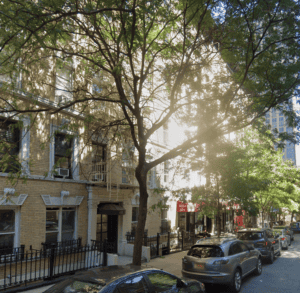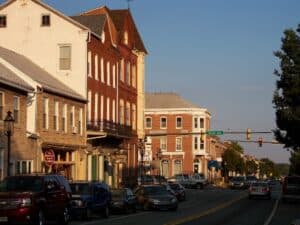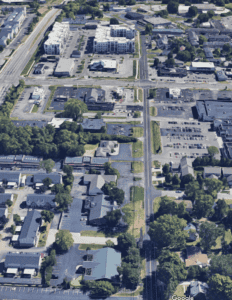In theory, this approach sets those districts up for success – the residents patronize businesses outside normal work hours and give the area character; the first-floor businesses activate the street. All this is great if it works – but it neglects the complicated economics of vertically mixed-use buildings. A better approach is to zone affirmatively for every type of use that would make a downtown stronger, and let individual developers figure out the math.
Vacant stare
Zoning is fundamentally a defensive policy: it cannot create the good; it can only block the bad. For a main street, what’s the “bad” that should be blocked? Aside from the obvious cases, nothing kills the charisma of a downtown like vacancies. In the 2020s, planners are facing the realities of much-diminished demand for downtowns. The rise of online shopping in the 2010s and remote work in the 2020s permanently diminished demand for downtown space, and vacancies soared. So when planners are reevaluating commercial zoning codes, they shouldn’t ask what the ideal use – they should ask what uses are better than vacancy, and legalize all of those.
Vacancies aren’t just terrible for the city; they’re terrible for the landlord or developer. There are two ways that first-floor retail requirements kill RICZ: many residential developers don’t touch commercial space and those who do cannot afford to sit on empty commercial space waiting for lease-up. A downtown that’s already struggling is not likely to quickly provide commercial tenants willing to pay for large, brand-new commercial spaces.
Time and money
In many cities that restrict RICZ to upper stories, there’s a tacit understanding: A connected developer with a good project can get a rezoning or planned-unit development for an all-residential project. But although this process seems relatively painless to the city, the delay is expensive to the developer (especially with today’s high interest rates) and the uncertainty alone is enough to dissuade many developers from even beginning negotiations.
Embracing horizontal mixed use
Allowing all-residential projects in commercial zones doesn’t mean giving up on the promise of a great mixed-use main street or district. It just means thinking more flexibly about what “mixed use” means. Great cities, large and small, have areas where commerce and residences mix on varying terms.
In New York City, residential and commercial uses alternate along many streets and avenues. New York also serves as a reminder to other cities: even very high residential densities cannot support first-floor commercial uses on every lot.

At the opposite end of the size spectrum, many small towns have residences alongside small businesses along their main streets. From a distance, one cannot easily tell the use of a particular structure, as in Emmitsburg, Maryland.

Of course, most commercial districts are not so picturesque. Development along Old Henderson Road in Columbus mixes apartments, houses and businesses. Customers and residents come and go mostly by car. Still, the zoning is restrictive, so that a change from commercial to residential use (or vice versa) requires a rezoning.

Next steps
A major citywide rezoning is an expensive endeavor – but cities can get their RICZ back in action with a simple zoning text change.
- Identify every retail, office, and civic/institutional zone in the city;
- Set aside those where it would be unhealthy to live (such as a zone with heavy industry) or where the city cannot provide basic public services;
- Shift all forms of residential use to “allowed by right” status in the remaining commercial zones.
Hardly a city in the U.S. today does not claim to want residents back in their downtowns. But when I read zoning code after zoning code, I’m disappointed to see how few have gone through the simple step of shifting residential use to by-right status in commercial zones. It’s time to get our codes in line with our goals.









